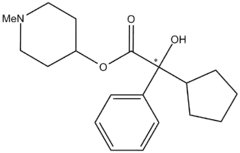EA-3443
EA-3443 is a potent and long lasting anticholinergic deliriant drug, related to the chemical warfare agent 3-Quinuclidinyl benzilate (QNB). It was developed under contract to Edgewood Arsenal during the 1960s as part of the US military chemical weapons program, during research to improve upon the properties of earlier agents such as QNB.
 | |
| Identifiers | |
|---|---|
IUPAC name
| |
| CAS Number | |
| PubChem CID | |
| ChemSpider | |
| UNII | |
| CompTox Dashboard (EPA) | |
| ECHA InfoCard | 100.110.337 |
| Chemical and physical data | |
| Formula | C19H27NO3 |
| Molar mass | 317.429 g·mol−1 |
| 3D model (JSmol) | |
SMILES
| |
InChI
| |
| (verify) | |
The main advantages of EA-3443 were not only increased potency over QNB, but also a significantly improved central to peripheral effects ratio. Anticholinergic drugs produce both incapacitating deliriant effects through action in the brain, and a variety of distinctive physical symptoms such as dry mouth, dilated pupils, blurred vision and hot flushed skin, all of which together comprise the "anticholinergic syndrome" which is generally easy for doctors to diagnose. EA-3443 however is mainly selective for the brain, and when administered in a narrow dose range of around 0.3 mg can produce the central effects of confusion, hallucinations and amnesia, but without producing significant physical symptoms, which was predicted to make poisoning with EA-3443 much more difficult to diagnose and treat. However, despite these advantages, EA-3443 was never researched to the same extent as QNB or manufactured in bulk, and research into EA-3443 was discontinued along with the rest of the US chemical weapons program in the mid-1970s.[1][2]
See also
References
- Commission on Life Sciences (1982). "N-Methyl-4-piperidinyl-(phenylcyclopentyl)-glycolate (EA-3443)". Possible Long-Term Health Effects of Short-Term Exposure to Chemical Agents. Vol. 1. The National Academies Press. pp. 189–191.
- Ketchum JS (2006). Chemical Warfare Secrets Almost Forgotten. A Personal Story of Medical Testing of Army Volunteers with Incapacitating Chemical Agents During the Cold War. ChemBooks Inc. ISBN 978-1-4243-0080-8.
| |||||||||||||||
|---|---|---|---|---|---|---|---|---|---|---|---|---|---|---|---|
| Blood agents |
| ||||||||||||||
| Blister agents |
| ||||||||||||||
| Nerve agents |
| ||||||||||||||
| Neurotoxins |
| ||||||||||||||
| Nettle agents |
| ||||||||||||||
| Pulmonary/ choking agents |
| ||||||||||||||
| Vomiting agents |
| ||||||||||||||
| Incapacitating agents |
| ||||||||||||||
| Lachrymatory agents |
| ||||||||||||||
| Malodorant agents |
| ||||||||||||||
| Biological toxins |
| ||||||||||||||
| Other |
| ||||||||||||||
| |||||||||||||||
| mAChRs |
| ||||
|---|---|---|---|---|---|
| Precursors (and prodrugs) |
| ||||
| |||||